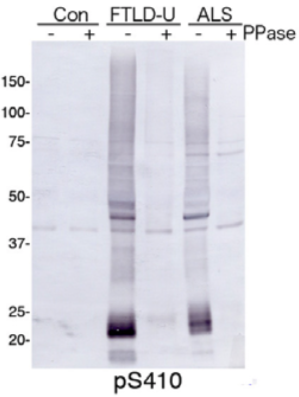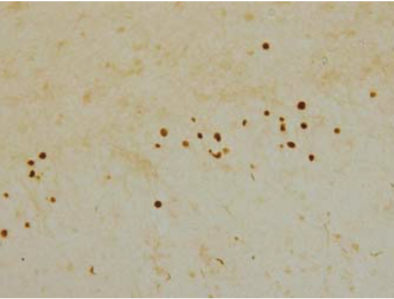
Anti TAR DNA-Binding Protein 43 (TDP-43), phospho Ser410 pAb (Rabbit, Antiserum)
CAC-TIP-PTD-P04
Product group Antibodies
Overview
- SupplierCosmo Bio USA
- Product NameAnti TAR DNA-Binding Protein 43 (TDP-43), phospho Ser410 pAb (Rabbit, Antiserum)
- Delivery Days Customer16
- CertificationResearch Use Only
- Scientific DescriptionAnti-TAR DNA-Binding Protein 43 (TDP-43), phospho Ser410 pAb was prepared from rabbits immunized with phospho-peptide [CMDSKSS(p)GWGM]. This pAb recognizes human TDP-43 phosphorylated on serine 410 and is validated for western blot, ELISA and IHC(f) analyses of TDP-43 proteinopathy. TDP-43, a heterogeneous nuclear ribonucleoprotein, was identified as a component of ubiquitin-positive and tau-negative inclusions observed in cases of frontotemporal lobar degeneration (FTLD-U) and amyotrophic lateral sclerosis (ALS). Immunochemical analyses using antibodies generated against phospho- and non-phosphopeptides of human TDP-43 revealed that abnormally phosphorylated full-length TDP-43 (45 kDa), C-terminal fragments (~25 kDa) and smearing substances are deposited as intracellular inclusions in affected regions of FTLD-U and ALS cases. This antibody is a powerful tool for biochemical and immunohistochemical analyses of neurodegenerative diseases and for evaluation of cellular or animal models of TDP-43 proteinopathy. Specifications Product type primary antibody Immunogen CMDSKSS(p)GWGM, S(p): phosphoserine 410 Raised in rabbit Source serum Form liquid antiserum with 0.05% NaN3 as a preservative Volume 100 uL Label unlabeled Specificity phospho-TDP-43 Cross reactivity human Storage below -20°C and below -70°C for prolonged storage; aliquot to avoid freeze/thaw cycles. Recommended dilutions Western blotting: 1/1000-1/3000 Immunohistochemistry: 1/1000-1/5000 ELISA: 1/1000-1/5000 Other applications not tested Optimal dilutions/concentrations should be determined by end user References <ol> Hasegawa M, Arai T, Nonaka T, et al. Phosphorylated TDP-43 in frontotemporal lobar degeneration and amyotrophic lateral sclerosis. Ann Neurol. 2008;64(1):60-70. doi:10.1002/ana.21425 </ol>
- UNSPSC12352203

